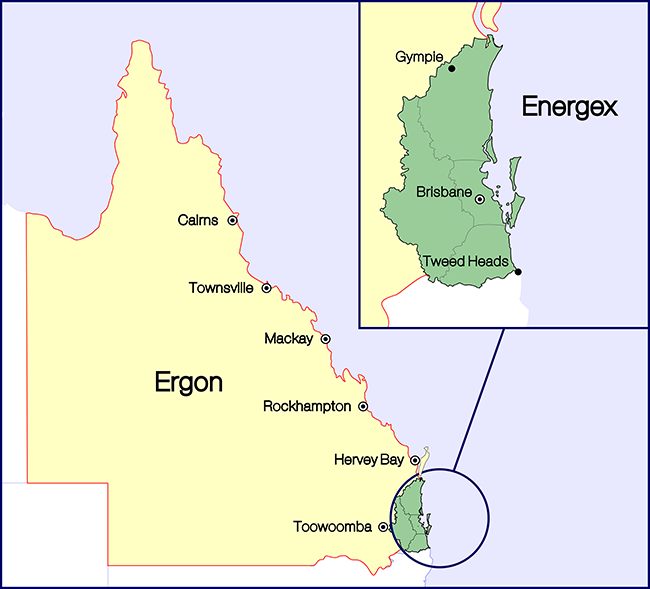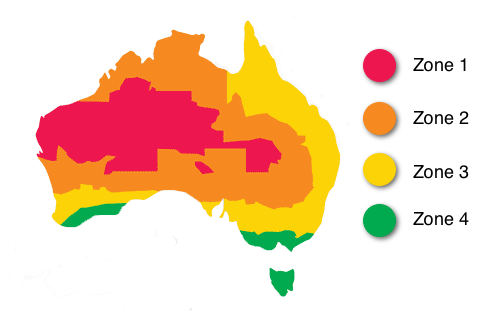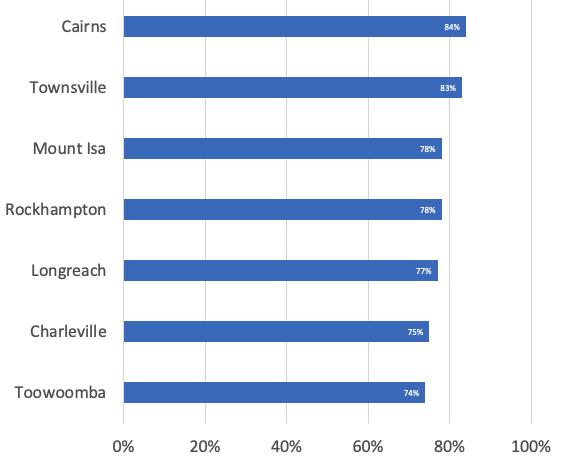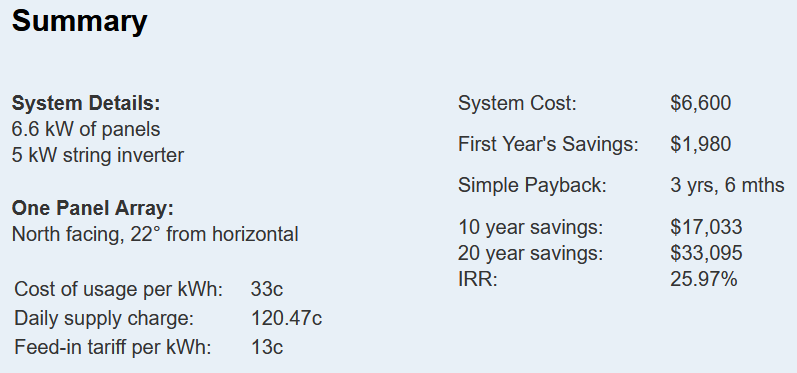Solar ‘101’ – Regional Queensland Edition
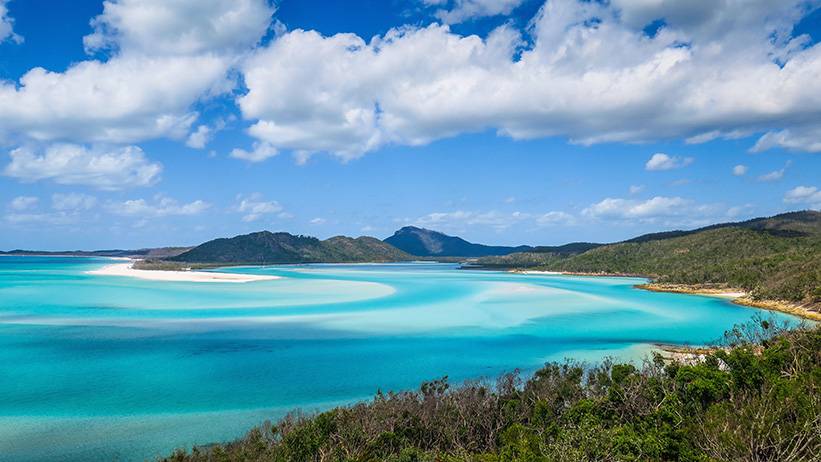
By Finn Peacock – Chartered Electrical Engineer, Ex-CSIRO, Founder of SolarQuotes.com.au
Last Updated: 8th Oct 2024
My all-of-Australia “Solar 101” beginners guide has helped well over 100,000 Australians go solar with confidence. They’ll enjoy the security of tiny bills for the foreseeable future.
This specific 101 guide focuses on what you need to consider when going solar in the Ergon network, which covers regional Queensland.
Queensland has two electricity networks (called DNSPs), Energex and Ergon.
When you buy a solar power system you need to be aware of local details, many of which depend on who your DNSP is. So, if you are in the Ergon DNSP network – this guide is for you.
- The good – and bad – of solar in the Sunshine State
- Solar rebates in Queensland
- Winter generation and energy use habits
- How panel direction affects Queensland solar energy production
- Costs for solar power in Queensland
- Solar systems (and exports) can be large
- Ergon often the only available electricity retailer
- What’s the best electricity tariff for a solar home?
- Are home batteries worthwhile?
- How long will solar power take to pay for itself in Queensland?
The good – and bad – of solar in the Sunshine State.
Queensland is a fantastic place for solar energy – but it’s not all smiles and sunshine!
The good
- Queensland’s climate and geography mean solar electricity output is consistent throughout the year. This is excellent for offsetting the needs of energy-guzzling appliances such as pools and air conditioners; even in the winter months.
- Queensland is a competitive market for solar power, so you can get a quality installation for a reasonable price.
- You can install a large system on a single-phase home in the Ergon network – as long as it’s export limited.
- At the moment, solar feed-in tariffs in the Ergon area are higher than what most Australians receive. Those not on the old 44 cent tariff get the Regional feed-in tariff, set by the Queensland Competition Authority, which is currently 13.4 cents.
- If your neighbour’s trees interfere with the proper functioning of solar panels (by shading your roof), the QLD government considers that a legitimate reason to force their removal (the trees that is). But I would advise trying to reach an agreement with your neighbour first before getting your chainsaw out.
The bad
- Because the market for solar power is so competitive, there is a race to the bottom for solar pricing in many areas. Low pricing attracts a lot of cowboys.
- While feed-in tariffs are good at the moment, they are set to fall in future as more people take advantage of solar in the Sunshine State.
- Some major population centres in regional Queensland are beginning to hit local transformer limits. This means new solar installations are starting to trigger ‘export limitations‘, affecting savings and payback.
- Hail is a hazard in many areas of Queensland – so it’s important to make sure your solar system is covered by your insurance from the get-go.
- Many solar installations require a switchboard upgrade (especially if it has asbestos in it!). Ergon rules require your installer to move your switchboard to the front of a property (closer to the grid connection point) if it’s upgraded. Depending on the distance moved, this can add a significant amount to costs.
- Your installer can apply for an exemption from moving the switchboard for various reasons – for example, if it would place the switchboard too close to a front window – and these exemptions are often granted. This is just one example where using a good local solar installer can save you heartache.
Solar rebates in Queensland
While everyone calls it the ‘solar rebate‘, its proper name is either the “SRES” or “STC scheme”. The gist is, installing solar panels generates ‘STCs’ – pieces of virtual paper your installer trades in for cash. They pass this value on to you as a point of sale discount. More panels = more rebate.
Australia is divided into four zones to calculate the value of the rebate – where zone 1 gets the most rebate, and zone 4 gets the least:
Pro-tip: The majority of Australians live in zone 3.
Most of Queensland’s population is located in zone 3, with inner-regional areas creeping into zone 2.
To use an example – if someone located in Cairns, which is in zone 3, were to buy a 6.6 kW solar system – it’d attract about $2,300 worth of rebates.
If someone located in Mount Isa were to buy the same 6.6 kW system, their zone 2 location means it’d attract about $2,500 worth of rebates.
Winter generation and energy use habits
Compared to somewhere such as Hobart, where there is a dramatic difference in average electricity generation between summer and winter, virtually all of Queensland has steady generation year-round:
Solar electricity output across the seasons is more consistent for two main reasons:
- Queensland is closer to the equator, which means the length of a day isn’t as dramatically different in summer compared to winter.
- Summers are cloudy, while winters have clearer skies.
Because of this, you don’t have to be as careful using appliances such as air conditioners and pool pumps in your home during the daytime compared to residents of other states. The sunnier winter weather gives you ample generation to offset your energy needs.
If you decide to install a home battery, this also means you don’t necessarily need to install a larger solar power system (for the extra winter generation) as I’d recommend in other states.
How panel direction affects Queensland solar production
Regardless of where you are in Australia, facing your panels north will generate the most energy over a year. So – if your goal is to maximize generation – face as many of your panels north as possible.
But if north isn’t an option for your roof, what generation will you lose if you face your panels east or west?
Well, I put this graph together to show the output of west or east-facing panels as a percentage of north-facing output for some major regional Queensland towns and cities:
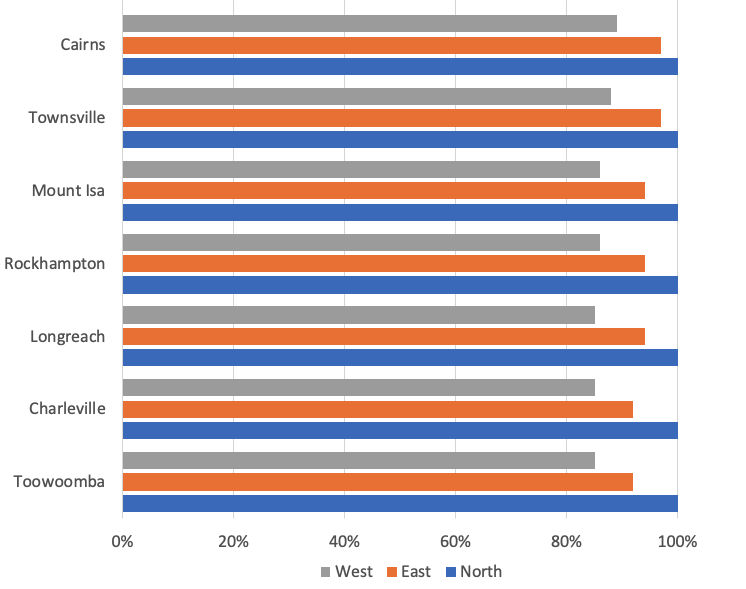
The further north you go, the smaller the gap in generation between north, east and west.
Even south-facing panels perform well in Queensland. Here’s the amount of energy you’ll generate from south-facing panels compared to north-facing:
Pro-tip: If you want to squeeze every last drop of energy out of your panels, face them slightly north-east.
So — provided you want to maximize solar generation — the closer you live to Toowoomba, the more you’ll want to have east-facing as your runner-up for panel facing. The closer you live to Cairns – the less it matters.
But many Queensland homes will be better off with west-facing panels. While they’ll produce a little less energy, they’re better for powering late afternoon air conditioning.
Costs for solar power in Queensland – and brands to trust
Here are the price ranges you can expect to pay for a 6.6 kW solar system in regional Queensland; installed by someone who cares:
- 6.6 kW: $5,500 – $9,000
- 10 kW: $8,000 – $13,000
- 13.3kW: $10,000 – $15,000
If your home is a particularly tricky solar installation requiring a scissor lift, an engineering report, micro-inverters, etc – anticipate paying more than these price ranges.
Also, note the further you are from a major population centre, the more you can expect to pay above and beyond these price ranges – usually 20% more for a rural area.
Pro-tip: You’ll be able to find companies selling systems for less than these ranges. My advice is to avoid these ‘too good to be true’ prices – as they often are.
Brands to trust
I’ve made the following charts to show brands of panels and inverters I’d be happy to install on my own home, as well as where they sit on price:
Solar Panels
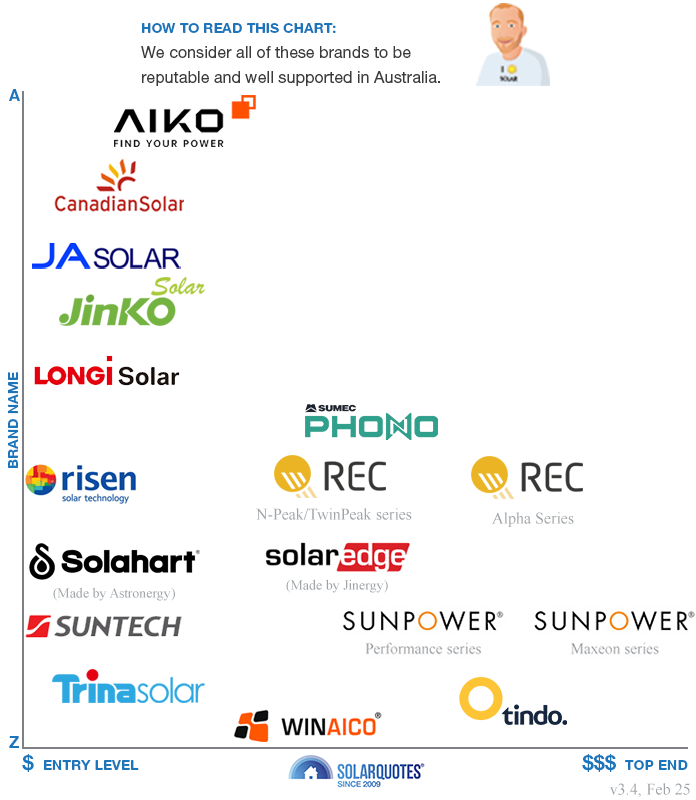
Solar Inverters
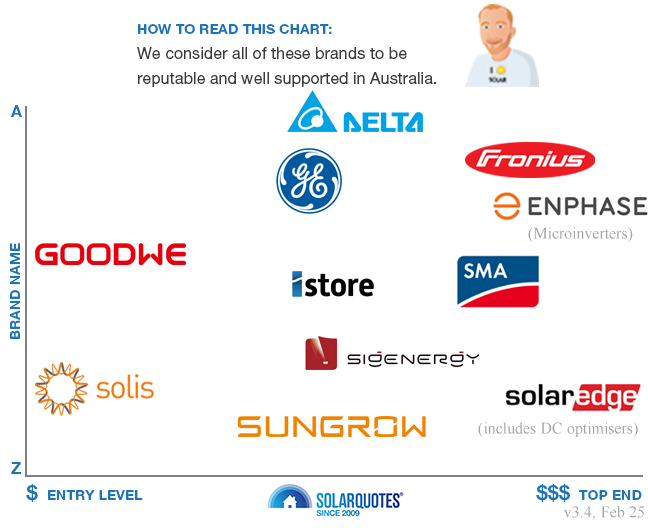
Despite the sales hype you might hear from some companies, I wouldn’t expect any particular brand to perform better in ‘regional Queensland conditions’ specifically over another.
Solar systems (and exports) can be large
Ergon Energy rules allow the following:
- Single-phase: 10 kW inverter limit, 5 kW export limit.
- Three-phase: 30 kW inverter limit, 15 kW export limit.
- SWER line (rural areas): 10 kW inverter limit, 2 kW export limit.
- Battery inverters: These may count towards the inverter limit.
- Optional dynamic export limit: This allows a flexible 1.5-10 kW export per phase instead of 5 kW.
Note that you’re allowed to ‘oversize’ the amount of panels on your roof by 133% of your inverter capacity.
So on a single-phase home, you can have up to 13.3 kW (10 kW inverter limit x 133%) of panels. On three-phase – a whopping 40 kW (30 kW inverter limit x 133%). It is rare a residential home could fit more than 30 kW, so if you have a 3-phase home you’re laughing.
In regional Queensland, battery inverters may count towards the inverter limit. This means if you want to ‘AC Couple‘ a battery, your solar system can’t be too big. But the good news is — at the moment — many households are being permitted to install AC coupled batteries without their battery inverter capacity affecting how much solar inverter capacity they can install.
For example, if you had a single-phase home and an 8 kW inverter with 10 kW of panels, then if the battery inverter counts towards the inverter limit you would not be able to install a Tesla Powerwall 2. This is because there’s a 5 kW battery inverter inside it and that would take you over the 10 kW limit. But so long as the battery inverter capacity isn’t included in the inverter total it’s okay.
If you have a rural property, there’s a good chance you’ll be on a SWER (Single Wire Earth Return) line. In this case, you’ll have a 2 kW export limit. This makes it extra important to shift electricity consumption to the daytime so your solar generation won’t go to waste.
Queensland has also introduced optional dynamic export limits. Rather than being limited to exporting 5 kW per phase, it will allow 1.5-10 kW to be exported per phase, depending on what the grid can handle. This has the advantage of potentially increasing the amount of solar energy your home exports to the grid.
Some regional QLD areas are getting saturated
We’ve had feedback from clients across Queensland indicating some local transformers in certain densely populated regional towns/cities are being pushed to their limits.
This means Ergon will no longer rubber-stamp approval for a 5 kW export limit per phase, and is starting to reduce its “automatic approval” for export limits in affected areas to 3 kW or less.
Pro-tip: Export limits affect your savings less than you might expect.
Ergon is often the only available electricity retailer
As well as being the Distributed Network Service Provider (DNSP) for regional QLD, Ergon Energy is also an electricity retailer. This means they are responsible for maintaining the electricity grid and are also responsible for offering electricity plans to homeowners, reading meters, and answering customer inquiries.
Ergon is, for the most part, a monopoly. While different retailers can operate, they generally don’t find it profitable so Ergon is often the only choice.
You can find Ergon’s current tariffs on this page.
What’s the best electricity tariff for a solar home?
Most homes in Queensland are on Ergon’s “tariff 11”, which is a standard ‘single rate’ tariff. These tariffs charge a flat rate for electricity.
If you install a new solar power system on your home, Ergon will replace your old meter with a new “smart” meter. This grants you access to four new tariff options:
- Time-of-use Tariff 12B
- Solar Soaker time-of-use tariff 12C
- Demand Tariffs 14A & 14B
If you change tariffs you can be locked into the new one for an entire year, so choose wisely!
Time-of-use tariff 12B & 12C
A time-of-use tariff charges you different prices for electricity depending on the time of day. “Peak” is from 4 to 9pm, “off-peak” from 9am to 4pm, and “shoulder” is from 9pm to 9am.
The 12B tariff offers a low rate during the day and a high rate in the evening, while the “Solar Soaker” 12C has a very low off-peak rate in the day and a very high evening peak rate.
The problem with time-of-use tariffs is they charge the most for electricity in the evenings, which is exactly when homes with solar panels are most likely to need to draw from the grid (because the sun is going down and their solar energy production is low). So it’s unlikely tariff 12B or 12C will make sense for the typical solar home.
But if a household gets a battery it can make time-of-use tariffs the best. West facing panels are also useful for homes on time-of-use tariffs because they’ll supply more solar energy during the early part of the peak period than panels facing other directions.
Demand tariff 14A & 14B
Demand tariffs can seem attractive to solar owners at face value. You are charged a lower daily supply charge and usage tariff, but the devil is in the detail and households can be hit with massive demand charges.
These charges are calculated by measuring the average grid power consumption over each half-hour period from 4pm-9pm every evening. The highest figure for entire month is then multiplied by the “demand charge rate”, which is $4.97 for demand tariff 14A. This applies to every day of the month, so if 3 kW was the maximum average power used in an evening half hour period, this would be multiplied by $4.97 to give $14.91 and this amount is applied to each day of the month. In a 30 day month it would total $447.
Demand tariff 14B has a usage charge that is 1.1 cents lower per kWh but the demand charge rate is $9.36 which is nearly 90% higher, making the demand charges nearly 90% worse.
My advice is – avoid demand tariffs unless you have a battery to help absorb high evening power draw from your home. And even then – chances are high you’ll have a flat battery one evening and trigger demand charges. Unless you get your kicks from trying to ‘beat the house’, demand tariffs are unlikely to be for you.
Pro-tip: Unless your home has a battery or unusual energy usage habits, you’ll be best off on a standard single rate tariff, such as Ergon’s tariff 11.
Is the time right for battery storage?
The Queensland Government introduced a “Battery Booster” program in early 2024. This offers a subsidy of up to $3,000 for home batteries – or up to $4,000 for low income households – making them worthwhile for many regional Queensland households. But the amount of funding is limited and this scheme may soon end.
You will still need high enough evening electricity consumption and a reasonably large solar system to get a financial return from installing a home battery. But because batteries provide other benefits, such as backup power and reduced fossil fuel emissions, many will find them worthwhile even if they don’t expect savings on electricity bills to completely pay for them.
What does easily pay for itself is solar. If you install as much as will reasonably fit on your roof you’ll be ready if you decide to get a home battery — or a battery on wheels in the form of an electric vehicle.
Every day you don’t have solar is another day you do have to pay high electricity bills. A well designed solar system with or without batteries can give you tiny bills.
So consider going solar now – don’t lose years of savings if you’re not sure batteries are worthwhile.
How long will solar take to pay for itself in Queensland?
I’ll use my nifty solar calculator to answer this question:
Assuming:
- A 6.6 kW solar system in Bundaberg, facing north, costing $6,600
- An unshaded roof
- A house on tariff 11 with an average usage tariff of 33 cents per kWh
- Feed-in tariff rounded to 13 cents per kWh
- Solar energy self-consumption is 20%
My calculator shows you’ll save $1,980 in the first year and have a simple payback period of 3 years, 6 months:
Try getting that kind of return from the bank!
The next step
Queensland is one of the best places in Australia for solar power. If you own an unshaded roof, I believe you’re crazy if you don’t have solar.
If you have any burning questions about the information in this guide, my contact details are:
Email: [email protected]
Tel: 08 7200 0177
Snail mail: 3/39 Grenfell St, Adelaide, SA 5000 Australia
If you’re in regional Queensland and looking for quotes, SolarQuotes can help you get quotes from high quality, heavily vetted installers quickly and easily:
Happy Solar Power Hunting!
Finn Peacock, founder of SolarQuotes.com.au
